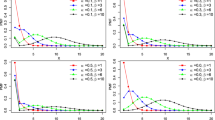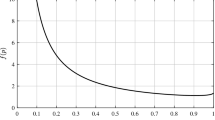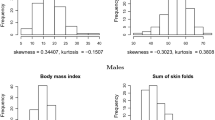Abstract
The use of the Pareto distribution as a model for various socio-economic phenomena dates back to the late nineteenth century. Recently, it has also been recognized as a useful model for the analysis of lifetime data. In this paper, we apply the approximate studentization method to obtain inference for the scale parameter of the Pareto distribution, and also for the strong Pareto law. Moreover, we extend the method to construct prediction limits for thejth smallest future observation based on the firstk observed data.
Similar content being viewed by others
References
Abramowitz, M. and Stegun, I. (1972).Handbook of Mathematical Functions. New York: Dover.
Arnold, B.C. and Press, S.J. (1983). Bayesian inference for Pareto populations.Journal of Econometrics 12, 287–306.
Cox, D.R. (1975). A note on partially Bayes inference and linear models.Biometrika 62, 651–654.
Dyer, D. (1981). Structural probability bounds for the strong Pareto law.Canadian Journal of Statistics 9, 71–77.
Fraser, D.A.S. and Wong, A. (1993). Approximate studentization with marginal and conditional inference.Canadian Journal of Statistics 21, 313–320.
Fraser, D.A.S. and Wong, A. (1996). On the accuracy of approximate studentization.Statistical Papers, to appear.
Geisser, S. (1984). Predicting Pareto and exponential observables.Canadian Journal of Statistics 12, 143–152.
Johnson, N.J. and Kotz, S. (1970).Distributions in Statistics: Continuous Univariate Distribution I. New York: Wiley.
Kalbfleisch, J.G. (1985).Probability and Statistical Inference, Volume 2. New York: Springer-Verlag.
Mahmoud, M. and Maswadah, M. (1992). Structural inference on the parameters of the Pareto distribution from complete and censored life test data.Statistical Papers 33, 57–68.
Mandelbrot, B. (1960). The Pareto-Levy law and the distribution of income.International Economic Review 1, 79–106.
Nigm, A.M. and Hamdy, H.I. (1987). Bayesian prediction bounds for the Pareto lifetime model.Communication in Statistics: Theory and Methods 16, 1761–1772.
Shuie, W.K. and Bain, L.J. (1983). A two-sample test of equal gamma distribution scale parameters with unknown common shape parameter.Technometrics 25, 377–381.
Student (1908). On the probable error of the mean.Biometrika 6, 1–25.
Wong, A. (1995). On approximate inference for the two-parameter gamma model.Statistical Papers 36, 49–59.
Author information
Authors and Affiliations
Rights and permissions
About this article
Cite this article
Wong, A. Approximate studentization for Pareto distribution with application to censored data. Statistical Papers 39, 189–201 (1998). https://doi.org/10.1007/BF02925406
Received:
Revised:
Issue Date:
DOI: https://doi.org/10.1007/BF02925406




